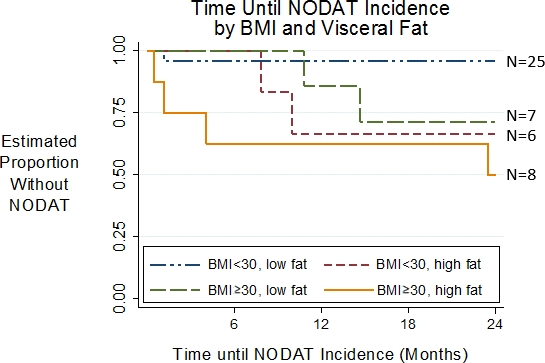Analytic Morphomics May Identify Risk Factors for New Onset Diabetes After Kidney Transplantation
D. Cron,1 M. Terjimanian,1 J. Augustine,2 D. Cote,3 K. Noon,3 V. Vaughn,4 S. Wang,1 M. Englesbe,1 K. Woodside.3
1Surgery, University of Michigan Medical School, Ann Arbor, MI
2Medicine, Case Western Reserve University, Cleveland, OH
3Surgery, Case Western Reserve University, Cleveland, OH
4Internal Medicine, University of Michigan Medical School, Ann Arbor, MI.
Meeting: 2015 American Transplant Congress
Abstract number: A179
Keywords: Metabolic complications, Morbidity, Obesity
Session Information
Session Name: Poster Session A: Kidney: Cardiovascular and Metabolic
Session Type: Poster Session
Date: Saturday, May 2, 2015
Session Time: 5:30pm-7:30pm
 Presentation Time: 5:30pm-7:30pm
Presentation Time: 5:30pm-7:30pm
Location: Exhibit Hall E
Intro:
We have previously shown that analytic morphomics can predict risk of new-onset diabetes after liver transplantation (NODAT). We hypothesize that these methods may be able to identify risk factors for NODAT in kidney transplant recipients as well.
Methods:
We retrospectively reviewed 47 non-diabetic patients who underwent kidney transplantation and received pre-operative (within 1 yr) abdominopelvic CT scans at a single institution between 1/2006 and 10/2011. Analytic morphomic methods were used to measure visceral fat area and total psoas area at the L4 vertebral level, and these measures were standardized by gender. The primary outcome was incidence and persistence of NODAT. Time until NODAT incidence was analyzed using survival analysis techniques (Kaplan-Meier, univariate Cox regression).
Results:
Median follow-up time was 4 years. There were 9 cases (20%) of NODAT all within 2 years of engraftment. BMI was a significant predictor of NODAT (Hazard ratio [HR]=1.2 per point increase, P=0.002). Visceral fat area was also a significant predictor (HR=2.5 per SD increase, P=.006), though total psoas area was not (HR=1.4, P=0.31). The figure shows time until NODAT incidence, stratified by BMI (< or ≥ 30) and visceral fat ("high"=upper tertile). Patients with BMI ≥30 and high visceral fat had the highest rates of NODAT incidence (50% by 2 yrs).
Conclusion:
Our preliminary results show that higher visceral fat and BMI, but not trunk muscle size, correlate with higher incidence of NODAT. Further study may provide better insight into the relationship between body composition, analytic morphomics, and NODAT in kidney transplant recipients.

To cite this abstract in AMA style:
Cron D, Terjimanian M, Augustine J, Cote D, Noon K, Vaughn V, Wang S, Englesbe M, Woodside K. Analytic Morphomics May Identify Risk Factors for New Onset Diabetes After Kidney Transplantation [abstract]. Am J Transplant. 2015; 15 (suppl 3). https://atcmeetingabstracts.com/abstract/analytic-morphomics-may-identify-risk-factors-for-new-onset-diabetes-after-kidney-transplantation/. Accessed July 18, 2025.« Back to 2015 American Transplant Congress
